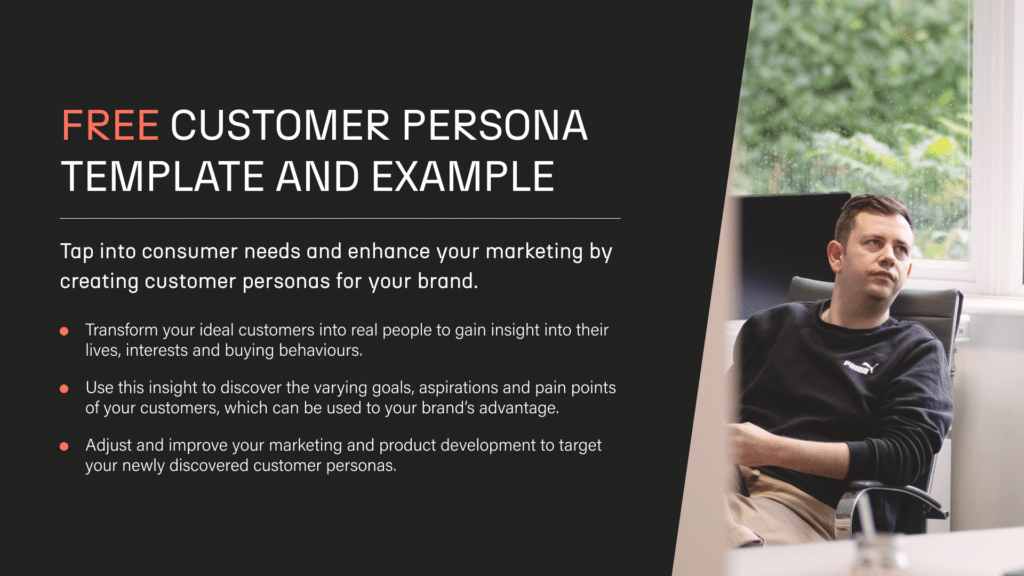How to Create a Customer Persona: With Examples & Template
How well do you know your customers? Their goals? Their problems? How about their challenges? Understanding the very people who visit your website and buy your products is a powerful way to grow your brand, but many businesses don’t go far enough when it comes to getting to know their customers inside and out.
One of the best ways to discover what makes users tick is to create a set of customer personas. In this guide, you’ll learn what customer personas are, how they can help your business, and find out how to create a customer persona. We’ve also included some downloadable resources to help you optimise the customer persona creation process, which you can grab for yourself below.
Quick Links
- What Are Customer Personas?
- Why Use Customer Personas?
- How to Create Customer Personas
- Creating Personas from Research
- Download Free Customer Persona Template
- How to Use Personas in Sales & Marketing

What are Customer Personas?
Customer personas represent your ideal customer. As such, they’re semi-fictional profiles based on quantitative data, market research and user behaviour. Companies use customer (or buyer) personas to inform their marketing strategies, align sales comms and reach their desired demographic with targeted messaging.
Most brands have an idea of their audience and make assumptions about their likes, dislikes and aspirations based on their demographic. Creating customer personas removes this guesswork, giving you a model through which to target customers that’s based on deep audience research and data.
How many customer personas should you have?
Because users interact with your brand in different ways, you’ll need to create a handful of customer persona examples that represent all your customers. This can be done by aligning basic demographic information with user-behaviour patterns, classifying users into segments that define your customer personas.
Why Use Customer Personas?
Customer personas can bring great value to your business. Here are the four main advantages of using customer personas:
Get to know your customers better
Building customer personas will give you a clearer view of your customers’ likes, dislikes, aspirations, desires, habits, and pain points. Essentially, it will help you to view them as living, breathing people. From this, you can target different groups with focused messaging, which will improve your sales and marketing strategy and increase brand advocacy.
Segment your marketing
One of the most powerful ways to use customer personas is to segment your marketing campaigns, creating unique messaging and ads for each group. Tailoring your campaigns in this way ensures they’re effectively targeted towards the right users, maximising ROI, and improving the overall experience for the user.
Develop new products, services and UX elements
Customer personas give you deep insights into your users and customers which can be used to inform new products and services, as well as to improve the overall user experience. Discovering behaviour patterns and pain points through buyer personas is an effective way to improve and refine different aspects of your business.
How to Create Customer Personas
Customer personas are only effective when they incorporate real-world data. The goal is to establish who your customers are as opposed to who you’d like them to be. Follow the steps outlined below to harness deep audience research to create compelling customer personas.
Research User Behaviour
Identify Problems and Aspirations
One of the biggest advantages of building customer personas is having greater insight into what customers want from your business. Understanding what their problems, pain points and aspirations are will make it easier to solve issues and deliver a better user experience.
There are several ways to uncover customer problems and desires; here are a few strategies to try:
Use social listening to engage with your audience
Social listening is a great way to pick up on problems, work out how to solve them, and engage with your audience. There are several tools available which allow you to monitor different social channels from one interface, including Hootsuite. You can target different topics, conversations, and keywords, including your brand name, to analyse user sentiment and discover problems of which you may not be aware. It’s a great way to find out what customers like and dislike about your brand, so you can make improvements and incorporate the insights into your personas.
Use surveys, questionnaires and interviews
As with audience discovery and research, surveys and interviews are a great way to uncover user pain points. Again, use incentives to encourage users to take part in surveys, asking them questions about their experience on your website, their views on your brand and products, and what brought them to your business.
Check in with your customer service team
Customer service teams are perfectly placed for engaging with customers. Ask them for feedback on some of the most commonly asked questions, themes, and complaints that customers have about your service, and this will give you a good picture of what’s working and what isn’t from a product and service perspective. It can also be a good idea to ask customer service teams to carry out customer interviews on your behalf, collating any feedback to inform your customer personas.
Be Clear on How You Can Benefit Users
It can be difficult to take an objective view of your business and see your products and services from your customers’ perspective. The great thing about building customer personas is the insights they give into how customers perceive your brand; insights which you can use to develop in the right areas, refine your offering and solve your customers’ problems.
Take the data you’ve collected about your customers and think objectively about how you can solve any problems and pain points and ultimately give them what they want. Understanding how to serve each of the customer categories in your persona index is crucial, and will inform how you use the personas to transform your messaging and develop engaging campaigns for each persona.
Creating Personas from Your Research
When the time comes to build out your customer personas, the task can be overwhelming. With reams of data to input and analyse, spotting characteristics, patterns and trends can be tricky – and that’s before you’ve even started creating categories and segments.
So where should you start? Begin by splitting the data into core groups. These can include things like age, gender, marital status, and geographic location. Then, consider the more abstract data and begin to look for patterns. Perhaps some of your users are twentysomethings who enjoy exercise and live in a city, while others are in their fifties, have children of their own, and live in the countryside. How can you use these individual personas to inform your marketing and ensure that individual users are being served the right kind of experience and information?
From these characteristics, you can begin to create personas which fit each demographic and social group. Build a character which has a name, job title, age, home type and other defining traits. The information you use should, naturally, be based on statistics taken from your data, but don’t make each persona too specific, otherwise you could narrow things down too much and miss out on attracting other types of customers.
Aim to create a profile which appears like an ordinary person whilst capturing a segment of your customer base. Not every user will meet each category 100%, but the personas themselves will help you see the human element in your business, and present you with a great opportunity to target different demographics and social groups.
Download Free Customer Personas Example
Need a little extra help? Get things off on the right foot with the help of our model Customer Persona Document, which features some handy customer persona examples so you can get a sense of what things should look like.

After you’ve done that, be sure to then fill in your Customer Persona Template with the key insights and info that’ll let you define who you do business with.
How to Use Customer Personas to Inform Sales and Marketing
When you’ve built a set of tailored customer personas, it’s time to set them to work for your business. There are many ways to leverage the insights from personas to inform sales and marketing decision-making – here are a few ways to use them to your advantage:
Alter your approach to customer service
The deep insights collated by analysing user behaviour on social media should influence where you allocate customer service resource. If, for example, you notice more engagement from one platform, make sure that your customer service representatives are actively monitoring these channels to help with customer enquiries.
Consider reallocating ad spend
Now that you know more about your customers, whether it’s their interests or where they like to shop, you can use these insights to inform where the majority of your ad spend is located. Targeting sites and sources where you know your customers are guarantees maximum ROI and a lower cost per acquisition for your paid media campaigns, so it could pay to audit where your spend is targeted.
Improve messaging for different persona groups
Different persona groups have different ways of communicating, particularly online, so this should influence how your business communicates with them in return. Think about your messaging and make sure it resonates with each type of persona group; use appropriate language, words, and phrases, and make sure this is consistent across your business.
Update your website content
If the bulk of content on your website was created before developing customer personas, it may be necessary to audit existing pages to make sure they align with the needs of your persona groups. Consider language, themes, context, and individual pain points, so that all your website content marries up with your personas. You may need to reassess your brand guidelines, too, and communicate any tone of voice and design changes to third parties and affiliates.
Segment your remarketing list by customer persona
If you regularly send remarketing emails to your customer base, it’s certainly worth taking the time to segment each user by the most relevant customer persona. This ensures that the experience they have of your marketing and website aligns with their preferences, maximising your chances of repeat purchases and conversions.
Develop dynamic content for each persona group
If your current website delivers one experience for all users, developing a dynamic approach which meets the needs of every persona group is a powerful way to increase engagement and conversions. Displaying different messaging, products and services for individual users is the perfect way to use your customer personas to their utmost, giving your customers a tailored experience that aligns with their preferences and sets out to solve their problems.
If you need help discovering your customers and users, Banc can help. Our teams use the latest tools and processes to collect quantitative and qualitative data about your customers, creating a bespoke strategy to encourage conversions and maximise ROI. Head here to learn more or call us today on 0345 459 0558.

